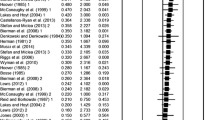Abstract
Research studies are briefly reviewed to examine the hypothesis that delinquent adolescents may process information in a different manner than non-delinquents. Studies suggest that delinquents may have less control over which information they attend to, may expose themselves to more stimulation, may process information more slowly, and may selectively attend to different information than matched controls. Findings from a recent study are presented in support of the latter hypothesis. A clinical example illustrates how these attention differences may appear in the course of treatment.
Similar content being viewed by others
References
Aichorn, A. (1960).Wayward Youth Meridian Books, New York. (Original published in 1925).
Allen, T. W., and Rosenthal, R. H. (1981). Salience effects upon habituation rates in learning disabled and hyperkinetic children, in preparation.
Cantwell, D. P. (1978). Hyperactivity and antisocial behavior.J. Am. Acad. Child Psychiat. 17: 252–262.
Curtiss, G., Feczko, M. D., and Marohn, R. C. (1979). Rorschach differences in normal and delinquent white male adolescents: A discriminant function analysis.J. Youth Adoles. 8: 379–392.
DeMyer-Gapin, S., and Scott, T. J. (1977). Effect of stimulus novelty on stimulation seeking in antisocial and neurotic children.J. Abnorm. Psychol. 86: 96–98.
Gibson, E. J. (1969).Principles of Perceptual Learning and Development, Appleton-Century-Crofts, New York.
Gough, H. G. (1960). Theory and measurement of socialization.J. Consult. Psychol. 24: 23–30.
Hare, R. D. (1968). Psychopathy, autonomic functioning and the orienting response.J. Abnorm. Psychol. Monogr. 73 No. 3, Part 2.
Hare, R. D. (1978). Electrodermal and cardiovascular correlates of psychopathy. In Hare, R. D., and Schalling, D. (eds.),Psychopathic Behavior: Approaches to Research Wiley, Chicester, pp. 107–144.
Lani, F., Doheny, M., Curtiss, G., and Rosenthal, R. H. (1981). affective ratings of inconsistent messages, distractibility, and role-taking in normal and delinquent adolescents, in preparation.
Lewis, D. O., and Balla, D. A. (1976).Delinquency and Psychopathology Grune and Stratton, New York.
Marohn, R. C., Dalle-Molle, D., McCarter, E., and Linn, D. (1980).Juvenile Delinquents: Psychodynamic Assessment and Hospital Treatment Brunner/Mazel, New York.
Odom, R. D., and Guzman, R. D. (1972). Development of hierarchies of dimensional salience.Dev. Psychol. 6: 271–287.
Offer, D., Marohn, R. C., and Ostrov, E. (1979).The Psychological World of the Juvenile Delinquent, Basic Books, New York.
Ostrov, E., Marohn, R. C., and Rosenwein, T. (1972). The Impulsivity Index: Its application to juvenile delinquency.J. Youth Adoles. 1: 179–185.
Quay, H. C. (1965). Psychopathic personality as pathological stimulation seeking.J. Abnorm. Psychol. 47: 810–817.
Rosen, A., and Schalling, D. (1974). On the validity of the California Psychological Inventory Socialization Scale: A multivariate approach.J. Consult. Clin. Psychol. 42: 757–765.
Rosenthal, R. H., and Allen, T. W. (1980). Intratask distractability in hyperkinetic and non-hyperkinetic Children.J. Abnorm. Child Psychol. 8: 175–187.
Satterfield, J. H. (1978). The hyperactive child syndrome: A precursor of adult psychopathy? In Hare, R. D., and Schalling, D. (eds),Psychopathic Behavior: Approaches to to Research Wiley, Chicester.
Schactel, E. E. (1966).Experimental Foundations of Roschach's Test Basic Books, New York.
Shapiro, D. (1960). A perceptual understanding of color response. In Rickers-Ovsiankina, M. A. (ed.),Rorschach Psychology Wiley, New York.
Shaw, C. R., and McKay, H. D. (1942).Juvenile Delinquency and Urban Areas University of Chicago Press, Chicago.
Strutt, G. F., Anderson, D. R., and Well, A. D. (1975). A developmental study of the effects of irrelevant information on speeded classification.J. Exper. Child Psychol. 20: 127–135.
Walters, R. H. (1953). A preliminary analysis of the Rorschach records of fifty prison inmates.J. Project. Techn. 17: 437–446.
Whitehill, M., DeMyer-Gapin, S., and Scott, T. J. (1976). Stimulation seeking in antisocial preadolescent children.J. Abnorm. Psychol. 85: 101–104.
Zentall, S. S. (1975). Optimal stimulation as theoretical basis of hyperactivity.Am. J. Orthopsychiat. 45: 549–563.
Zuckerman, M. (1971). Dimensions of sensation seeking.J. Consult. Clin. Psychol. 36: 45–52.
Zuckerman, M. (1978). Sensation seeking and psychopathy. In Hare, R. D., and Schalling, D. (eds.),Psychopathic Behavior: Approaches to Research, Wiley, New York.
Author information
Authors and Affiliations
Additional information
This work was conducted while Dr. Rosenthal was a Clinical Research Training Fellow in Adolescence in a program jointly sponsored by the Adolescent Program of the Illinois State Psychiatric Institute, the Institute for Psychosomatic and Psychiatric Research and Training at Michael Reese Hospital and Medical Center, and by the Departments of Behavioral Science (Human Development) and Psychiatry of the University of Chicago. The training program was funded by Public Health Service grant T32MH14668.
Received his Ph.D. in clinical psychology at Vanderbilt University. Current research interests include delinquency, hyperkinesis, and evaluation of hospital treatment.
Received his Ph.D. in clinical psychology at Loyola University. Current research interests include social cognition in delinquency.
Rights and permissions
About this article
Cite this article
Rosenthal, R.H., Lani, F. Selective attention and self-control in delinquent adolescents. J Youth Adolescence 10, 211–220 (1981). https://doi.org/10.1007/BF02088971
Received:
Issue Date:
DOI: https://doi.org/10.1007/BF02088971




